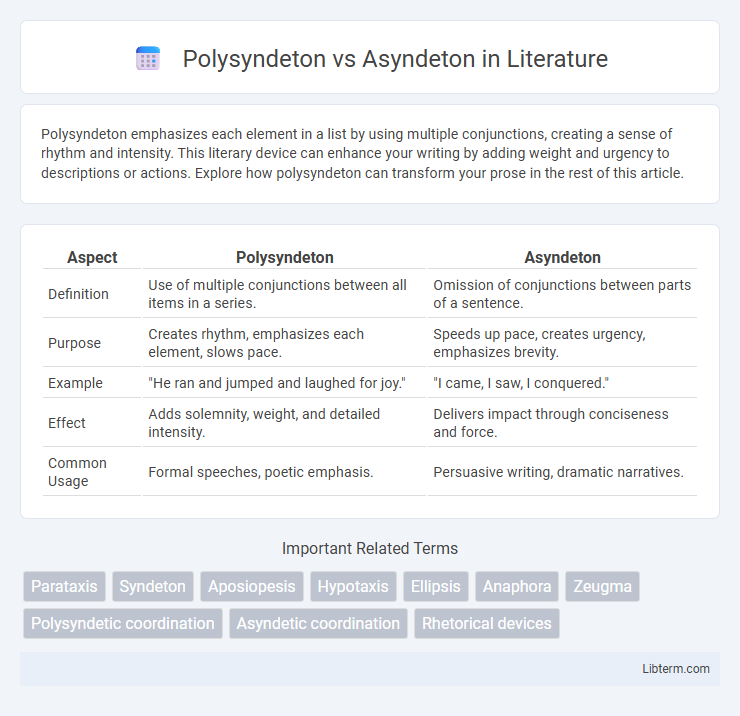Polysyndeton emphasizes each element in a list by using multiple conjunctions, creating a sense of rhythm and intensity. This literary device can enhance your writing by adding weight and urgency to descriptions or actions. Explore how polysyndeton can transform your prose in the rest of this article.
Table of Comparison
| Aspect | Polysyndeton | Asyndeton |
|---|---|---|
| Definition | Use of multiple conjunctions between all items in a series. | Omission of conjunctions between parts of a sentence. |
| Purpose | Creates rhythm, emphasizes each element, slows pace. | Speeds up pace, creates urgency, emphasizes brevity. |
| Example | "He ran and jumped and laughed for joy." | "I came, I saw, I conquered." |
| Effect | Adds solemnity, weight, and detailed intensity. | Delivers impact through conciseness and force. |
| Common Usage | Formal speeches, poetic emphasis. | Persuasive writing, dramatic narratives. |
Introduction to Polysyndeton and Asyndeton
Polysyndeton involves the deliberate use of multiple conjunctions in close succession to create a rhythmic and emphatic effect, enhancing the emotional intensity of a sentence. Asyndeton, in contrast, omits conjunctions between words or phrases to produce a concise, fast-paced, and impactful expression. Both rhetorical devices manipulate sentence structure to influence the reader's perception and tone.
Defining Polysyndeton: Meaning and Usage
Polysyndeton is a rhetorical device characterized by the deliberate use of multiple conjunctions between words, phrases, or clauses to create a rhythmic and emphatic effect. This technique enhances the intensity of the expression by slowing the pace and adding weight to each element, often conveying a sense of abundance or urgency. Commonly found in literature and speeches, polysyndeton contrasts with asyndeton, which omits conjunctions for a more rapid and concise flow.
Understanding Asyndeton: Meaning and Application
Asyndeton is a rhetorical device characterized by the deliberate omission of conjunctions between a series of words, phrases, or clauses, creating a fast-paced and impactful effect. This technique enhances the rhythm and intensity of speech or writing by producing a concise and memorable expression, often found in political speeches, literature, and advertising. Understanding asyndeton involves recognizing its role in emphasizing urgency, simplicity, and emotional power by stripping away connectors that typically slow down the flow of language.
Key Differences Between Polysyndeton and Asyndeton
Polysyndeton involves the deliberate use of multiple conjunctions between clauses or phrases, enhancing rhythm and emphasizing each element, while asyndeton is characterized by the omission of conjunctions to create a faster-paced, concise, and impactful statement. Key differences include polysyndeton's use of repeated conjunctions like "and" or "or," which slows reading and underscores each item, contrasted with asyndeton's lack of conjunctions that speeds up the flow and builds intensity. These stylistic choices affect tone and emphasis, with polysyndeton often evoking solemnity or abundance and asyndeton conveying urgency or simplicity.
Historical Origins and Literary Background
Polysyndeton, characterized by the deliberate use of multiple conjunctions in close succession, traces its origins to ancient Greek and Latin rhetoric, where it served to emphasize rhythm and intensity in oratory and literature. Asyndeton, the omission of conjunctions for a concise and impactful effect, also emerged from classical rhetoric, notably employed by figures like Julius Caesar and Cicero to create a swift, dramatic pace. Both devices have been extensively utilized in various literary traditions to enhance narrative tone and emotional resonance through stylistic contrast.
Effects on Rhythm and Tone
Polysyndeton slows the rhythm of a sentence by using multiple conjunctions, creating a deliberate, weighty tone that emphasizes each element equally and builds intensity. Asyndeton accelerates the rhythm through the omission of conjunctions, producing a rapid, concise tone that conveys urgency or simplicity. Both devices influence pacing and emotional impact, with polysyndeton fostering a more methodical, immersive experience and asyndeton generating momentum and a sense of immediacy.
Famous Literary Examples
Polysyndeton appears in Charles Dickens' "A Tale of Two Cities," where repeated conjunctions heighten the emotional intensity and rhythm, such as in the phrase "and so he went, and so he searched, and so he found." Asyndeton is famously used by Julius Caesar in Shakespeare's "Julius Caesar" with the line "I came, I saw, I conquered," creating a rapid, impactful effect by omitting conjunctions. Both figures of speech manipulate sentence structure to evoke different moods, relying on the presence or absence of conjunctions to influence pacing and emphasis in classic literature.
Usage in Modern Writing and Speech
Polysyndeton emphasizes each element by using multiple conjunctions, creating a deliberate, rhythmic effect often found in literary works and persuasive speeches. Asyndeton, on the other hand, accelerates the pace by omitting conjunctions, producing concise, impactful statements frequently used in advertising and motivational talks. Modern writing employs polysyndeton to evoke emotion and complexity, while asyndeton drives urgency and clarity in both written and spoken communication.
Tips for Choosing Between Polysyndeton and Asyndeton
When deciding between polysyndeton and asyndeton, consider the desired pacing and emphasis within your sentence; polysyndeton, by using multiple conjunctions, slows the rhythm and adds weight to each item, enhancing a sense of abundance or intensity. Asyndeton, which omits conjunctions, accelerates the pace and creates a concise, impactful effect ideal for urgency or simplicity. Evaluate the emotional tone you want to convey and the clarity of your list to choose the most effective technique for your writing.
Conclusion: Enhancing Style with Coordinating Devices
Polysyndeton and asyndeton are powerful coordinating devices that enhance writing style by manipulating rhythm and emphasis. Polysyndeton uses multiple conjunctions to create a slow, deliberate pace and amplify intensity, while asyndeton omits conjunctions to produce a fast, concise, and impactful effect. Mastering these devices allows writers to strategically control tone and engagement, making their prose more dynamic and memorable.
Polysyndeton Infographic

 libterm.com
libterm.com